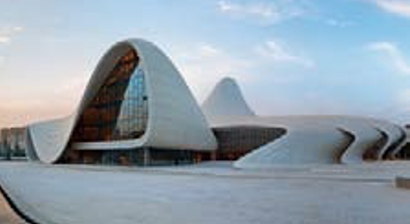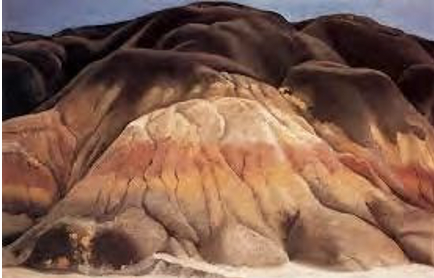On Past Societies, on selected Architecture, the Art of Andy Goldsworthy, Georgia O’Keefe, and my own Art Glass
Elizabeth Devereaux
Devereaux Architectural Glass, Chico, California
edevero@devglas.com
“Things are such, that someone lifting a cup, or watching the rain, petting a dog or singing, just singing – could be doing as much for this universe as anyone.” Rumi
INTRODUCTION
It is with these words, as well as the location of this Forum at Ghost Ranch, Georgia O’Keefe’s home and studio, that I am offering a “right brain” presentation (for a “left brain”-leaning group). I hope to illustrate with a powerpoint presentation some ways nature has inspired the spiritual lives of past societies, as well past and present architecture, and the work of artists Andy Goldsworthy, Georgia O’Keefe, and on my own architectural glass art.
You have asked us to consider:
how have experiences of nature and of otherwise ordinary things in our everyday existence have been elevated to the realm of the spiritual?
DEFINITIONS OF SPIRITUALITY (from the acsforum.org)
William James’s defines spirituality’ as “the attempt to be in harmony with an unseen order of things”. Also, “Spiritual experiences are realized individually and although possible to articulate, they cannot be completely conveyed due to the limited nature of our symbolic language.” 1
In the Huffington Post, “Heidi Campbell, a scholar of new media and religion at Texas A&M University, told The Huffington Post that spirituality on Instagram need not be tied to a church, temple or even a specific religion.
More than half of Americans between the ages of 18 and 29 use Instagram to share photos of everything from their family and friends to their travels and delicately-brewed Frappuccinos.
These millennials are also using the popular platform to showcase their spirituality. People may not use a cross or a picture of Mecca, but they’ll use a beautiful sunset or an inspirational quote to catch others’ attentions, Campbell said. Digital culture is all about turning the mundane into something sacred.” 2
Architect’s Definition of the term “spiritual”: Alexander – “possessing wholeness” Kahn – “immeasurable”
Le Corbusier – “ineffable”
Architecture that integrates, accommodates and expresses spirituality includes:
Places where earth energies are believed to converge.
Places built for separation from the mundane. (acsforum.org)
PLACES WHERE EARTH ENERGIES ARE BELIEVED TO CONVERGE
Mt. Shasta, Northern California:
Since at least 600 BC, possibly 2500 BC. Mt. Shasta was a corner territorial boundary for four Native American peoples – the Shasta, Modoc, Ajumawi/Atsuwegi, and Wintu – and within the view of the Karuk Tribe on the mid-Klamath River and the Klamath Tribe of the upper Klamath River. For all these native peoples, Mt. Shasta was the center of creation. 4
Mt. Agung, Bali:
Mount Agung has huge spiritual significance to the people of the island.
Balinese legend has it that Agung was created when the Hindu God Pasupati split Mount Meru (the spiritual axis of the universe) and formed Mount Agung with a fragment. 5
Denali, Alaska – Also known as Mount McKinley, is the highest peak in North America and holds great significance within the native traditions. “Denali” is translated as “the great one” in the Athabaskan languages of the Alaska Natives. 6

Mt. Shasta , Calif. Mt. Agung, Bali Denali, Alaska
ASTRONOMY AND ANCIENT CIVILIZATIONS:
Early civilizations, regardless of their differences, had one thing in common: astronomy was a backbone of their social, political, and religious systems. Astronomy is considered to be the most ancient science, study of the sky was a vital part of the theological foundation of early civilizations. The sky’s obvious effects on Earth led to the view of an intense connection between celestial events and human affairs. 7

PLACES BUILT FOR SEPARATION FROM THE MUNDANE.
The Great Egyptian Pyramids of Giza are some of the most magnificent man-made structures in history.
Somewhere in between human and divine, kings were believed to have been chosen by the gods to serve as mediators between them and the people on earth. 8
“Stonehenge” was built between roughly 5,000 and 4,000 years ago and it forms just one part of a larger, and highly complex, sacred landscape.
Uxmal – Yucatan, Mexico.
It is considered one of the most important archaeological and spiritual sites of Maya culture.

Egyptian Pyramids “Stonehenge”, England Uxmal – Yucatan, Mexico
Angkor wat , Cambodia
-was first a Hindu and later a Buddhist temple. It was built by the Khmer King Suryavarman II in the early 12th century. Breaking from the Shaiva tradition of previous kings, Angkor Wat was instead dedicated to Vishnu. 9
Mecca, Saudi Arabia
As the birthplace of Muhammad and the site of Muhammad’s first revelation of the Quran, Mecca is regarded as the holiest city in the religion of Islam, and a pilgrimage to it known as the Hajj is obligatory for all able Muslims. 10

Angkor wat , Cambodia Mecca, Saudi Arabia
ANCIENT ARCHITECTURE INSPIRED BY NATURE
Dome of the Rock Parthenon, (sacred geometry) Chartres

CONTEMPORARY ARCHITECTURE INSPIRED BY NATURE
Le Corbusier, Ronchamps Philip Johnson, Crystal Cathedral Adrian Smith, Burj Kahlif

ARTISTS WHOSE WORK IS INSPIRED BY NATURE
Andy Goldsworthy
British sculptor, photographer and environmentalist producing site-specific sculpture and land art situated in natural and urban settings. He lives and works in Scotland.

Andy Goldsworthy’s sculpture: because it is so intrinsically guided by the rhythms and processes of nature, there is no question of whether or how nature has inspired his art. His inquiry has brought into focus natural processes over time. Few people have taken the time to observe these
2015 Architecture, Culture, and Spirituality Symposium (ACS7)
natural processes – his “collaborations with nature”. The extraordinary documentary footage of “Rivers and Tides”, captures both his construction of a sculpture – the movement and changes, the growth and decay – like a time-lapse of a process in nature.
Georgia O’Keefe
Georgia O’keefe’s work began to be known in New York and in Lake George, with the pivotal support of her husband, photographer, Alfred Stieglitz, but after her early trips to the Southwest, she found the landscape of New Mexico both starkly beautiful and an irresistible draw.
She also became known for her magnified and sensual images of Hawaiian flowers, but Peter H. Hassrick, Director of The Georgia O’Keefe Museum, writes “more important to the development of her art were the indigenous subjects she found in New Mexico that occupied her work for the next fifty years.”….”The region’s majestic terrain, with its unusual geological formations, vivid colors, clarity of light, and exotic vegetation, provided ample visual resources for her to explore.”11

Also among the most powerful of her images were those involving animal bones and skulls. She wrote, “To me they are as beautiful as anything I know. To me, they are strangely more living than the animals walking around…the bones seem to cut sharply to the center of something that is keenly alive on the desert even tho’ it is vast and empty and untouchable – and knows no kindness with all its beauty.” 12

In many of her paintings the same process of growth and decay which are the focus of Andy Goldsworthy’s work are also visible, though in a very different way. Each artist collaborated with nature, and found nature and the land the inspiration for their work.
2015 Architecture, Culture, and Spirituality Symposium (ACS7) NATURE AS INSPIRATION FOR MY LIFE AND ARCHITECTURAL GLASS ART.
I do not pretend to compare my work to Georgia O’Keefe or Andy Goldsworthy, but we do share a common link: we each find nature (for the most part) our muse, and have immersed ourselves in its beauty, diversity, cycles, seasons, and mystery. The land is both spiritual teacher and lover, it is the grand creation, the holder of light and darkness; it is primary.
You ask what facilitates the connection between the everyday and the sacred in the built environment? There are many ways, but the focus of the ACS forum this year, the New Mexico landscape of Georgia O’Keefe, and Ghost Ranch, seems a very good place to share a ritual I have practiced for almost 40 years, and which is one of the greatest inspirations for my life, and my architectural glass art. In many landscapes, but particularly in one – the Anza Borrego Desert in Southern California – I have found nature to be a powerful metaphor for life and death, for the deeper spiritual meaning and passages of life.

RETREAT PRECEDENTS
Most religions have retreat and meditation practices. In Christianity, the Desert Fathers (there were also Desert Mothers) were male Catholic hermits, ascetics, and monks who lived mainly in the Scetes desert of Egypt beginning around the third century AD. The most well known was Anthony the Great, who moved to the desert in 270–271 and became known as both the father and founder of desert monasticism. 13
Hesychasm (Greek: hesychia, “stillness, rest, quiet, silence”)is a mystical tradition of prayer in the Eastern Orthodox Church and Eastern Catholic Churches of ByzantineRite.14 It is in this mode that for the last 40 years during Lent I have made a week-long retreat camping alone in the Anza Borrego desert. It has also become a time to take stock of my life, a time to draw, take photographs, hike, write and read.
Conclusion:
You have written in your ACS website:
“… this notion of spirituality, particularly if pursued primarily as an individual quest, runs the risk of elitism. The spiritual becomes an exercise in self-indulgence when it is relevant and accessible primarily to those who have managed to secure the more mundane aspects of their lives and thus have gained the freedom to contemplate what it means to seek fulfillment in the higher realms of enlightened consciousness.”
On the other hand, if a practice of “going apart”, essentially the same as a form of meditation, both informs and deepens the individual’s sense of spirit, of the numinous, and expands his/her knowledge of the diversity and beauty of the natural world, it becomes rather, a path of integration, than an exercise in “self indulgence”.
2015 Architecture, Culture, and Spirituality Symposium (ACS7) And if then, that experience imprints itself on the mind so that the subsequent creative expression – within any of the arts or sciences – is reflected in the built environment, it has deepened and enriched the “spiritually vacuous quotidian experience” for both the author and the audience.
Additionally, I consider this experience of time in nature a formation, and it is one way to facilitate the connection between the quotidian and the sacred in the built environment of today.
REFERENCES
- ACS website – “Definition of Spirituality”, acsforum.org, Seventh ACS Symposium, Ghost Ranch, NM. June 18-21, 2015
- “How Spirituality On Instagram Is Turning The Mundane Into Something Sacred” The Huffington Post | By Carol Kuruvilla,Posted: 05/13/2015
- ACS website – “Definition of Terms”, acsforum.org, Seventh ACS Symposium, Ghost Ranch, NM. June 18-21, 2015
4. www.sacred-destinations.com/usa/mount-shasta
- http://en.wikipedia.org/wiki/Mount_Agung Pringle, pp. 4,63
- www.huffingtonpost.com/…This Is The Most Spiritual Place In Your Home State The Huffington Post | By Yasmine Hafiz/ Posted: 05/29/2014
7://www.starteachastronomy.com/archaeoastronomy.htmlAstronomy of Ancient Cultures/ .leslie.welser@gmail.com
8. http://worldhistorys.tumblr.com/post/113449306257/historic-places-egyptian-pyramids-built
- www.history.com/topics/ancient-history/the-egyptian-pyramids
- en.wikipedia.org/wiki/Mecca
- “The Georgia O’Keefe Museum”, General Editor: Peter H. Hassrick, Director, Harry N. Abrams, Inc. Publishers, 1997.
- “About Myself”, in “Georgia O’Keefe: Exhibition of Oils and Pastels” (New York: An American Place,1939)
- http://www.coptic.net/articles/sayingsofdesertfathers.txt



